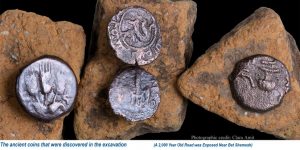There’s a joke in Israel that you can’t dig a hole in the ground without uncovering a major historical discovery. And it’s true! In most countries, important archaeological finds are rare, in Israel, significant and unusual finds are just a way of life.
Last year was a bumper year for archaeology, with the discovery of new Dead Sea Scroll fragments in the Judean Desert. Archaeologists believe more of these precious documents could still be found during renewed excavations in the Indianan Jones-sounding “Cave of Skulls.” The cave is named for the seven human skulls discovered there by Professor Yohanan Aharoni in 1960.
While finds on that level are rare, since the start of 2017, there have been a host of other exciting discoveries. These include a 1,400-year-old coin hoard uncovered during excavations in the widening of Highway 1, which runs between Jerusalem and Tel Aviv.
The nine bronze coins, struck at three different mints in Constantinople, Antioch and Nicomedia, bear the images of three important Byzantine emperors: Justinian (483-565 AD), Maurice (539-602 CE) and Phocas (547-610 CE). They were found beneath the ruins of a building, part of a large complex near En Hemed, that experts believe served Christian pilgrims on their way to Jerusalem.
Before the Mei Shemesh Corporation water company installed a pipeline in Bet Shemesh, the firm organized a salvage excavation to make sure it wasn’t operating in an archaeological site. This being Israel, it was! During the excavation, archeologists discovered a well-preserved 2,000-year-old road dating back to the Roman period.
This road, which is being conserved in situ for everyone to enjoy, measured up to six-meters-wide and ran for 1.5 kilometers. The newly discovered road linked the Roman settlement of Bit Nativ with the main highway known as the “Emperor’s Road.” which connected the large settlements of Eleutheropolis (Bet Guvrin) and Jerusalem.
Sometimes, people literally stumble on new discoveries. This happened to three hikers who were visiting caves in the Judean Shephelah. While they thought they were just checking out some hidden caves, they actually discovered a seven-branched Menorah and a cross hewn in the chalk bedrock.
The menorah has a base with three feet and represents the menorah that stood in the Temple during the Second Temple period. The cave also yielding another engraving, a key, along with other, as yet, unidentified carvings, giving archaeologists something new to puzzle over.
Just when you think there can be nothing left to discover, yet another important find comes to light. Who knows what other incredible discoveries will soon be uncovered.
By Danielle Max


